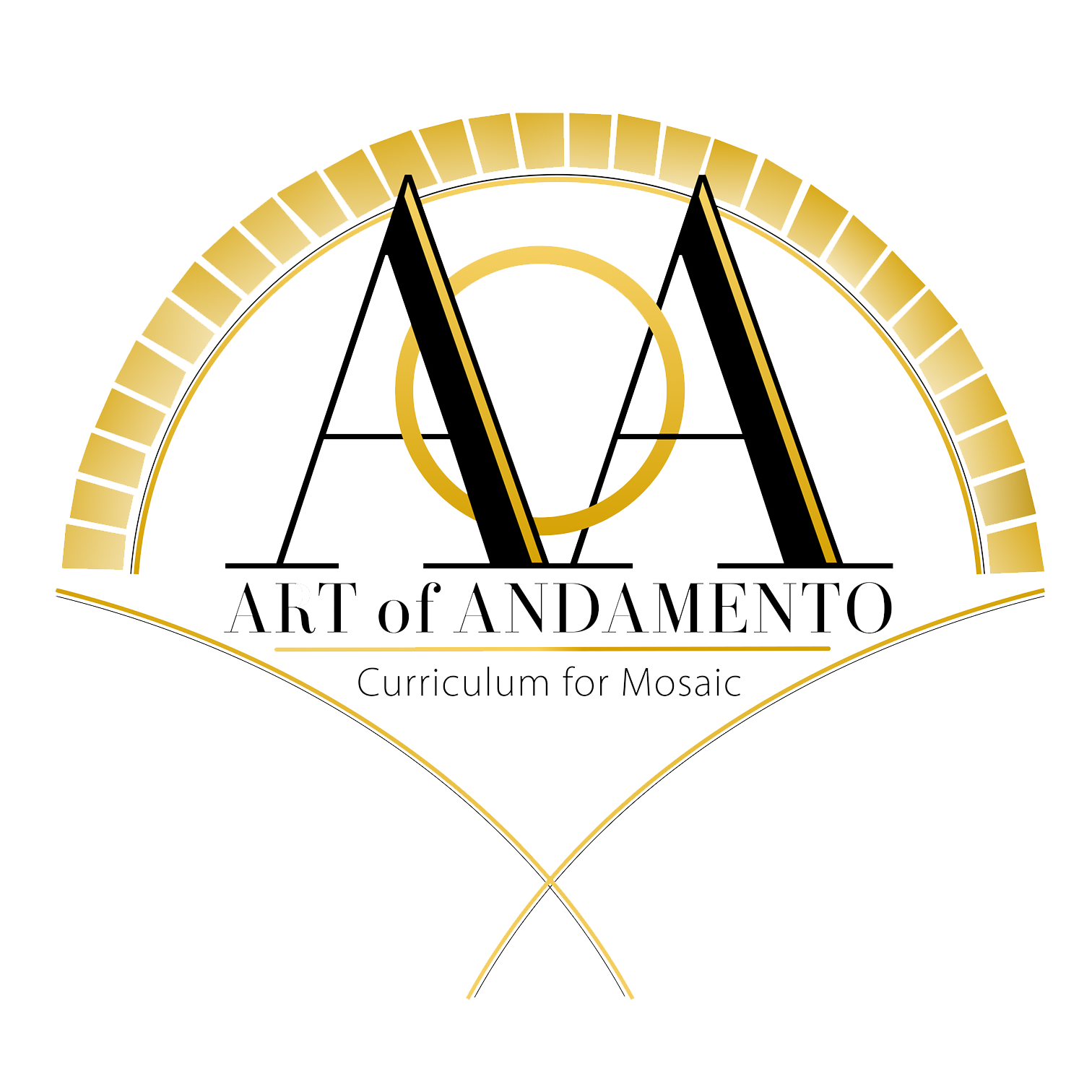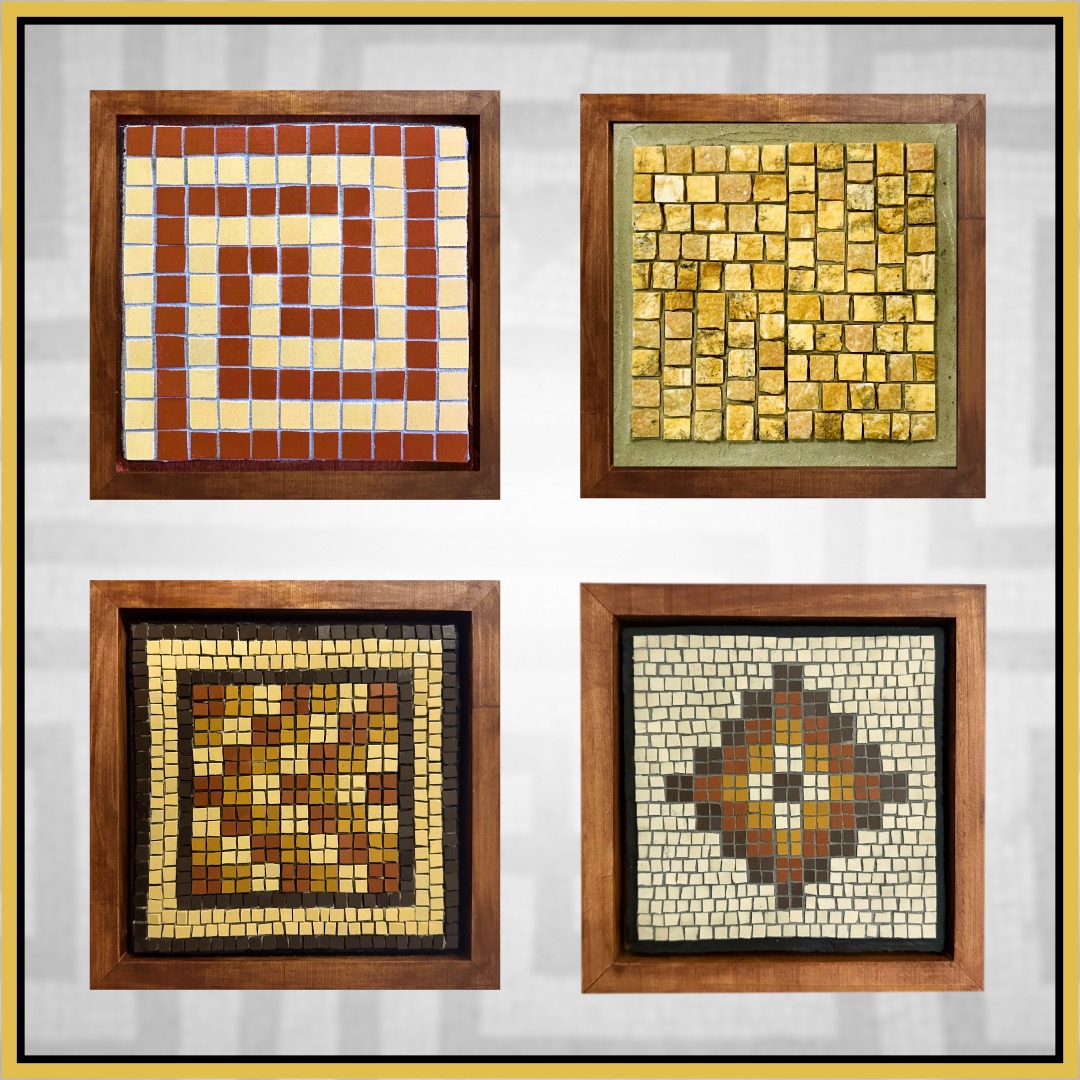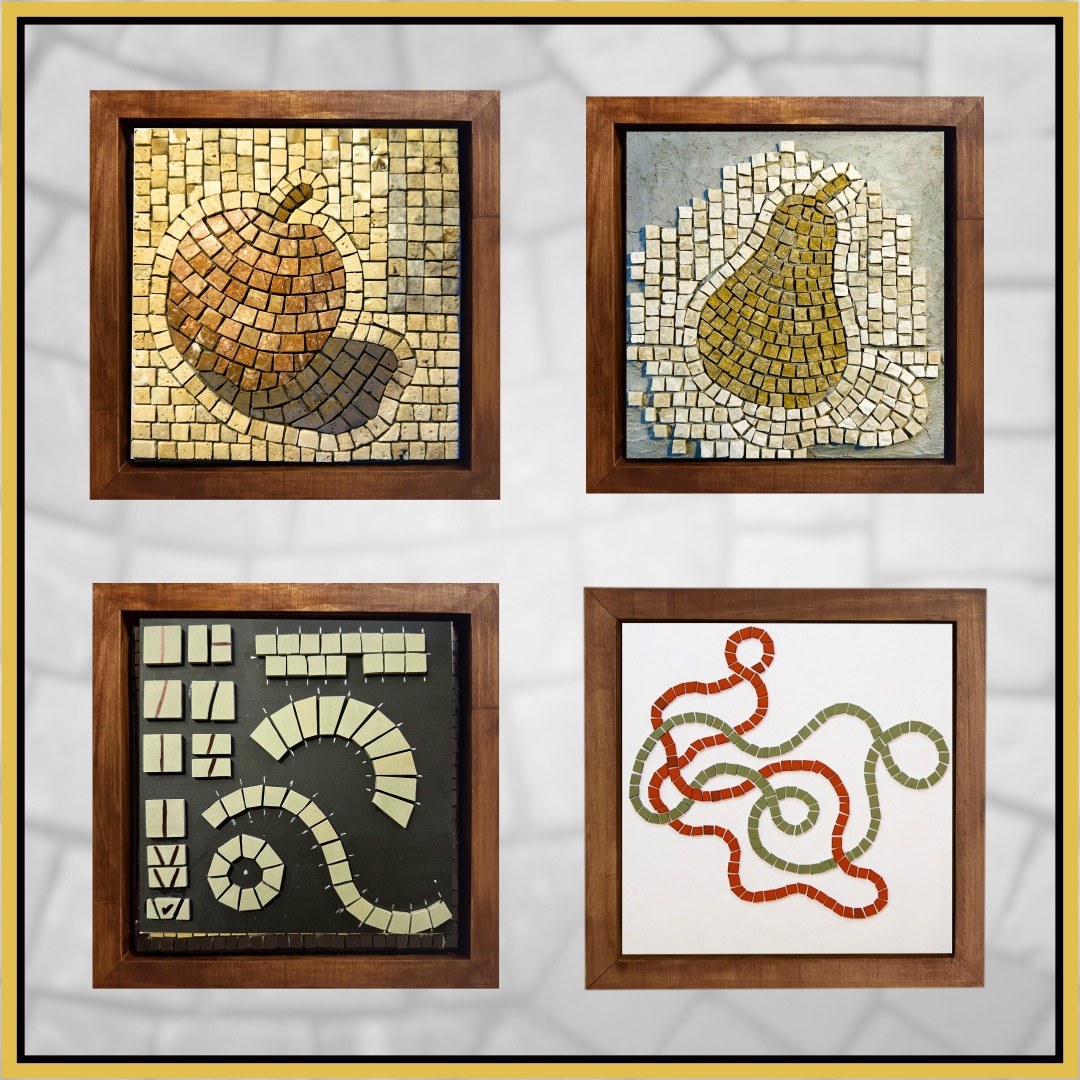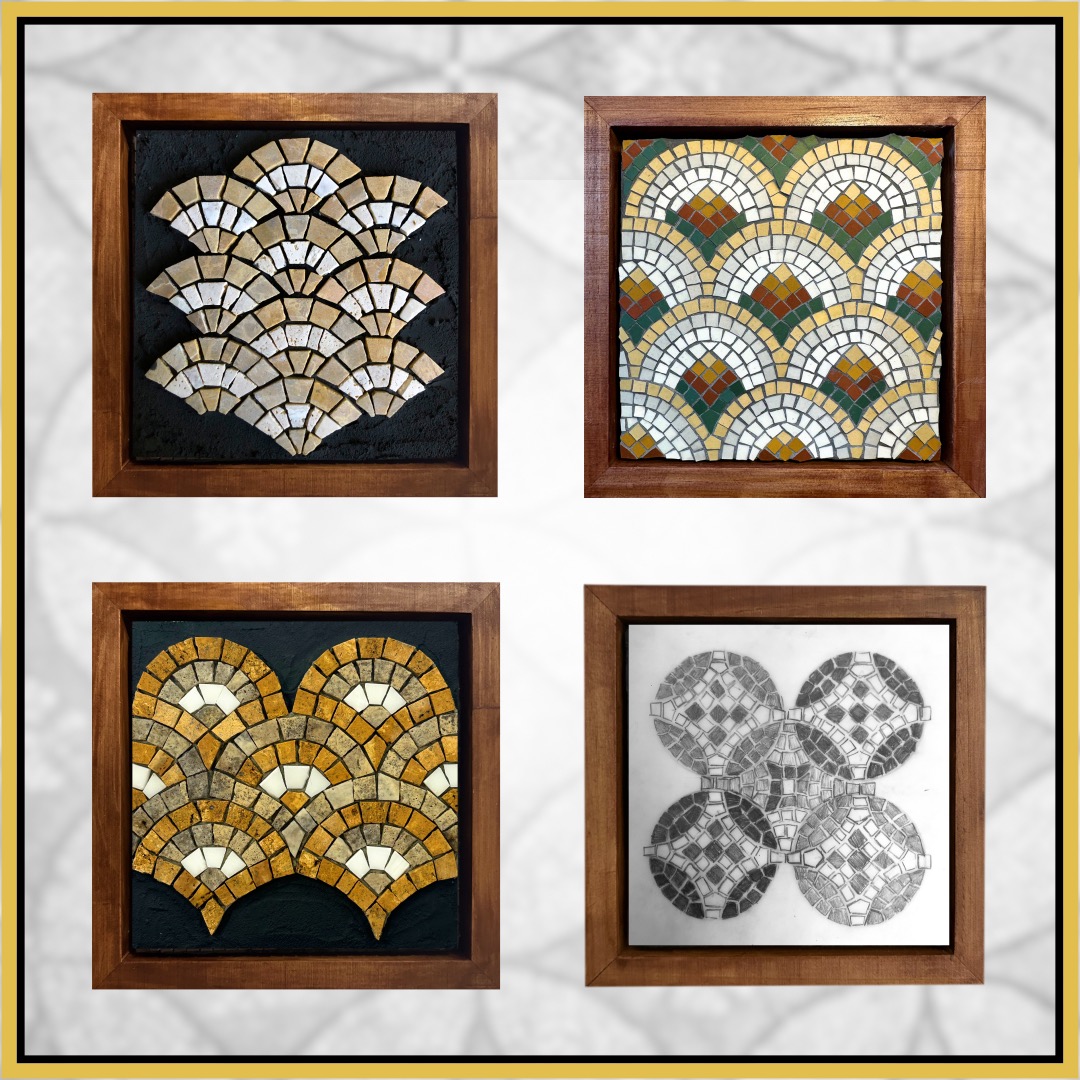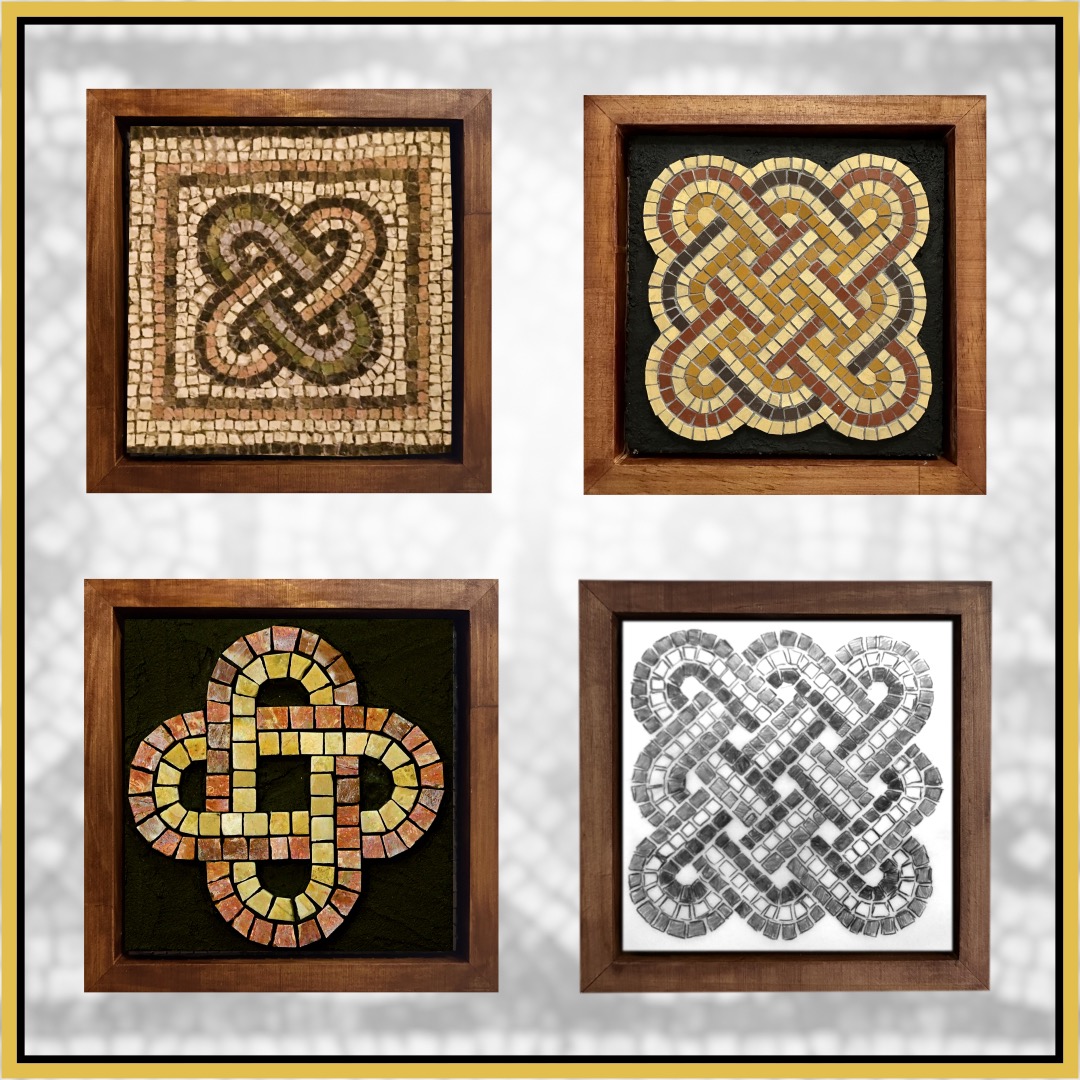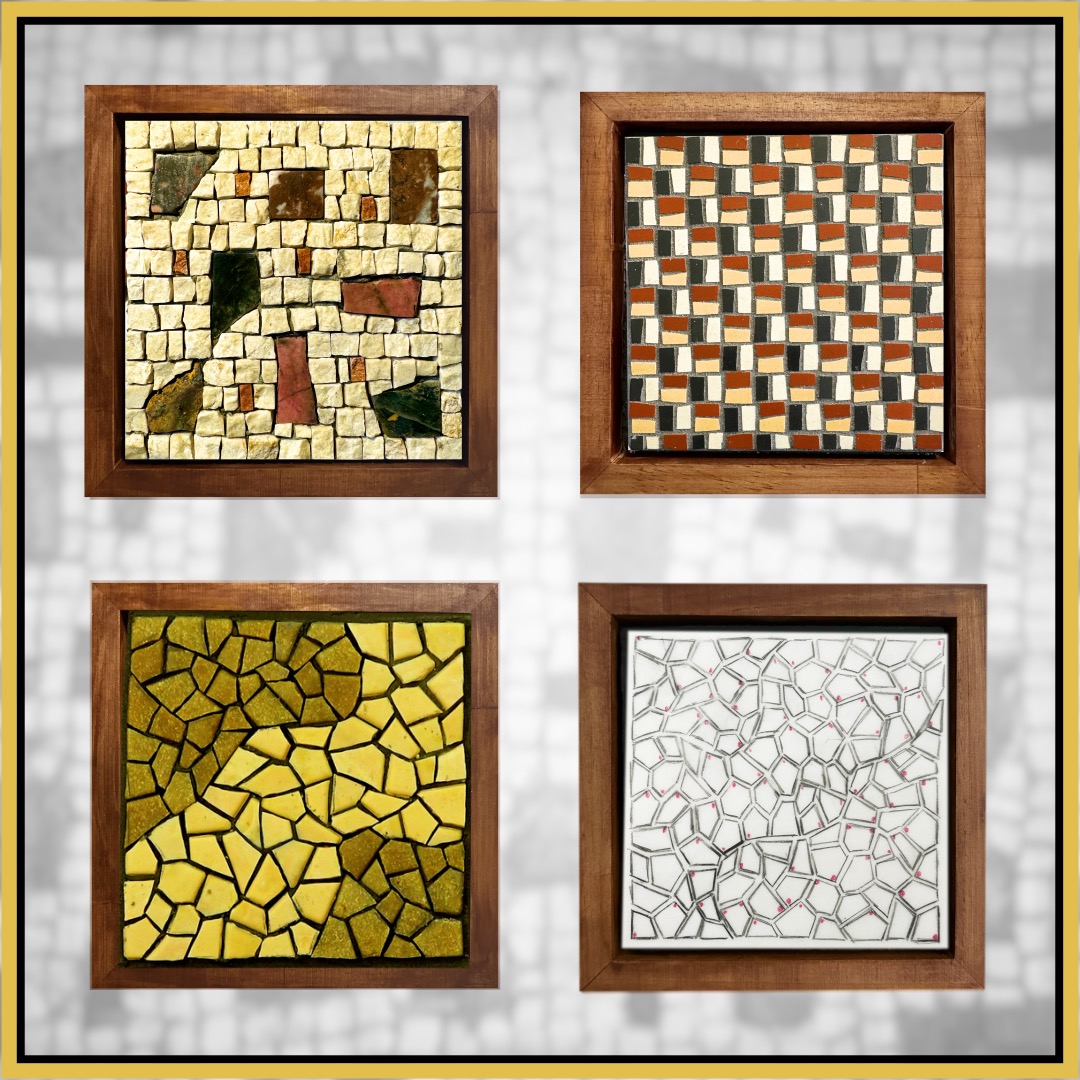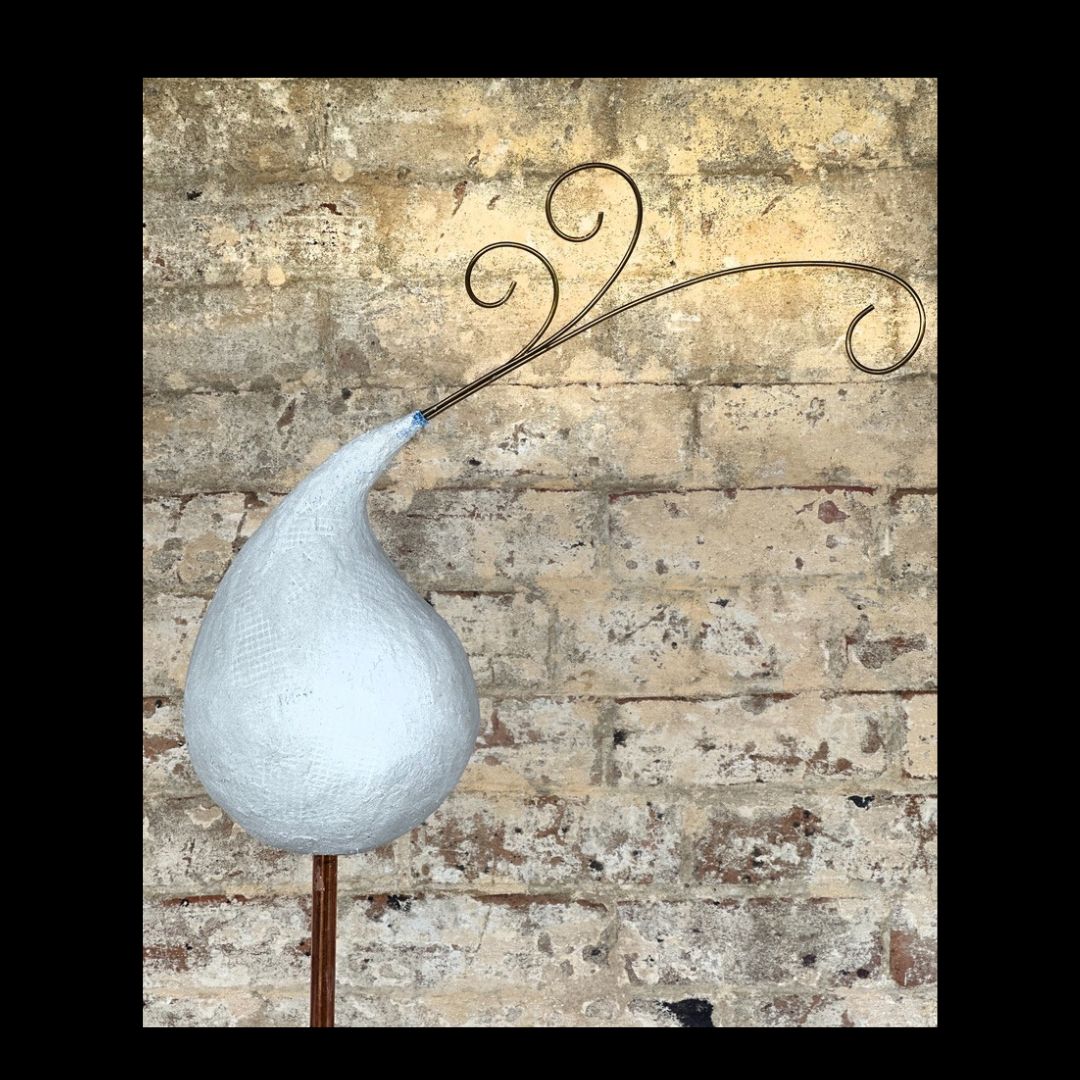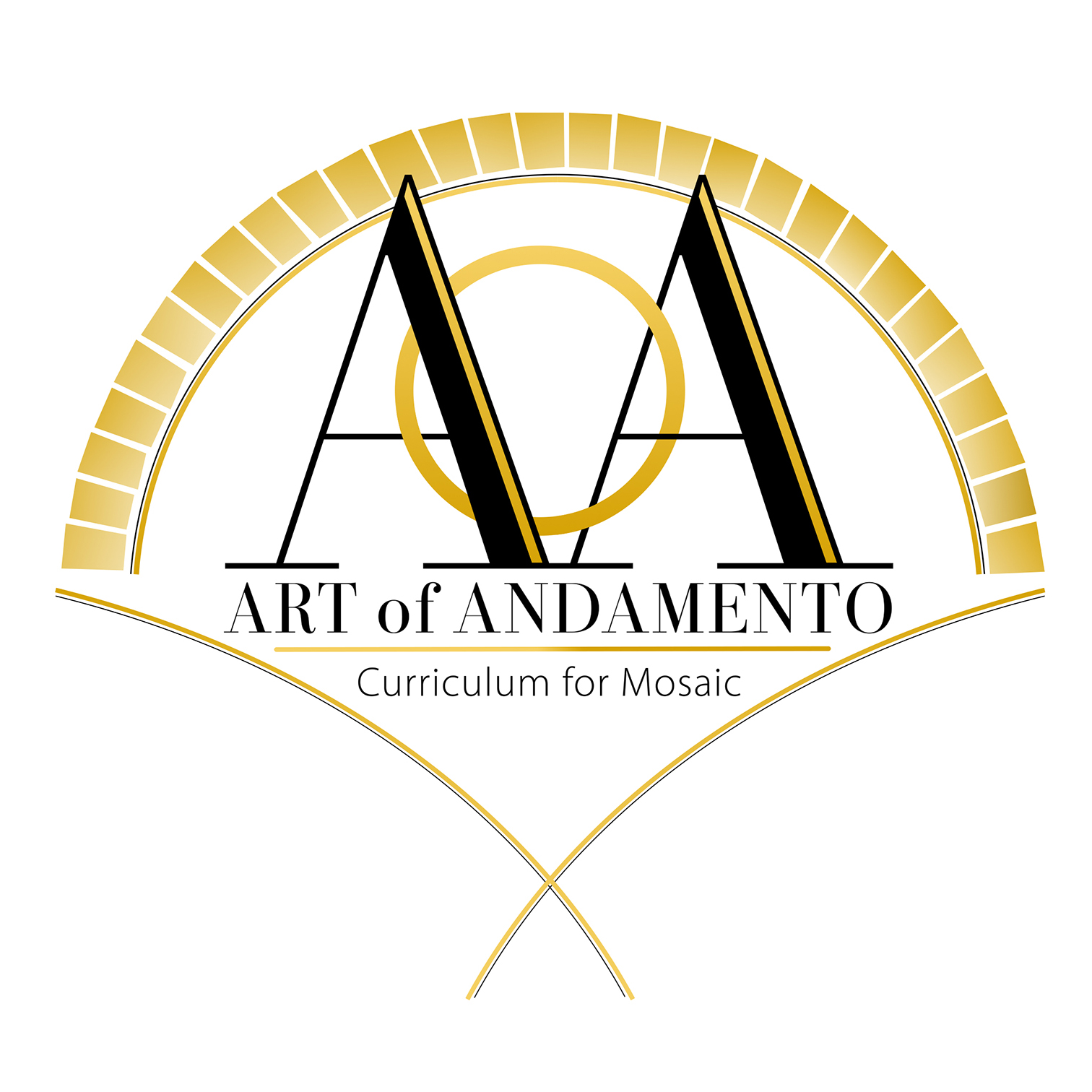
ART OF ANDAMENTO CURRICULUM
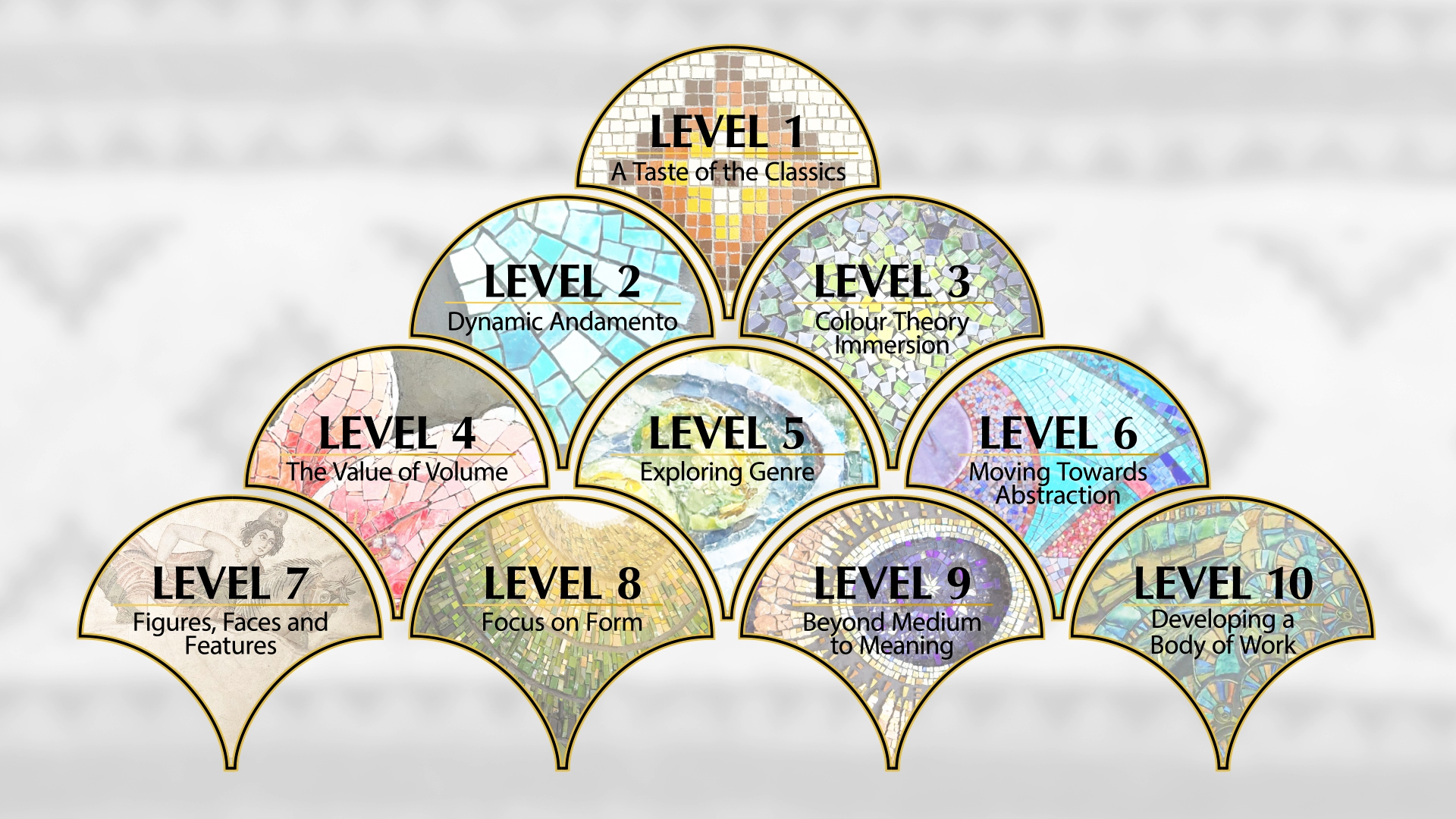
- LEVEL 1: A Taste of the Classics
- LEVEL 2: Dynamic Andamento
- LEVEL 3: Colour Theory Immersion
- LEVEL 4: The Value of Volume
- LEVEL 5: Exploring Genre
- LEVEL 6: Moving Towards Abstraction
- LEVEL 7: Figures, Faces, Features
- LEVEL 8: Focus on Form
- LEVEL 9: Beyond Medium to Meaning
- LEVEL 10: Developing a Body of Work
LEVEL 1 : A TASTE OF THE CLASSICS
This foundational level introduces five distinct approaches to creating mosaic patterns that are frequently seen in classical mosaic art.
These approaches encompass essential principles that form the basis for nearly all styles of mosaic, ensuring their relevance even in contemporary practices.
Classical mosaic patterns are seldom used in isolation; instead, they are typically combined with one another across different areas of a design to produce a variety of compositional effects.
To enhance students’ comprehension of each pattern’s structure, the foundational elements are first taught separately, allowing for a deeper understanding, and are then carefully integrated into more complex designs.
LEVEL 2 : DYNAMIC ANDAMENTO
Andamento is a powerful communicative tool in mosaic and a key element of mosaic design. The subject of a mosaic can often be conveyed through andamento alone before colour is introduced.
Described as an “Andamento Boot Camp,” this level presents structured methods to infuse mosaics with greater dynamism, movement, volume, energy, and expression, all without relying on colour to convey meaning.
Building on classical techniques from Level 1, this level advances towards contemporary mosaic andamento in a sequential manner, presenting technical challenges for all levels of experience.
Level 2 is currently being filmed and produced for re-release in early 2025.
LEVEL 3 : COLOUR THEORY IMMERSION
Many students are drawn to mosaic due to their strong sense of colour, but without a structured approach, colour imbalances can weaken their designs.
Level 3 : Colour Theory Immersion builds on previous knowledge by introducing colour theory systematically. This level enables students to identify, understand, and apply colour elements, to enhance or problem solve their mosaics with advanced colour techniques.
By exploring colour as a three-dimensional concept through the Munsell Colour System, students engage in exercises focused on Value, Hue, and Chroma.
Combining successful use of colour with sophisticated andamento, adds meaningful layers to their artwork.
Level 3 is due to be re-released in mid 2025.
LEVEL 4 : THE VALUE OF VOLUME
This level builds on and extends the skills acquired in Levels 2 and 3.
Level 2 emphasises dynamic andamento, teaching students to create dynamism, movement, volume, energy, and expression in mosaic without relying on colour. Level 3 delves into colour theory using the Munsell system, focusing on hue, value, and chroma.
Level 4 integrates these concepts through more advanced investigations, combining colour theory with dynamic andamento in more in depth but still stand-alone studies that challenge students to draw on skills learnt so far to solve problems and convey form.
Students refine their palette building, incorporating larger tesserae and mixed media. The exploration of andamento is deepened through the examination of value and volume as the basis of andamento planning.
Level 4 is still running live online through Hepworth Studios, next classes in 2025.
LEVEL 5 : EXPLORING GENRE
Level 5 is a thematic class designed for intermediate students who have completed the Andamento Level 3 course or an equivalent programme.
By exploring various popular genres in visual art and mosaic, students will deepen their understanding of the relationships between mosaic art and the broader art world.
They will apply the andamento and colour theory skills acquired in previous levels to explore multiple ways of interpreting, mediating, and composing imagery in larger, multifaceted compositions.
All tasks are supported by an examination of relevant visual art and mosaic theory related to each genre.
Students will engage in both theoretical research and practical exercises using a range of materials and techniques across the selected genres.
Current Genres include: Still Life, Landscape, Water.
In development: : Built Environment, Sealife, Birdlife, Wildlife
Level 5 is still running live online through Hepworth Studios, next classes in 2025.
LEVEL 6 : MOVING TOWARDS ABSTRACTION
With many students drawn to abstraction in mosaic, this level provides context and meaning to the evolution of abstraction as an artistic approach.
Each unit will examine how selected Modernist artists distanced themselves from traditional systems of patronage and forged avant-garde paths that embraced independent practice and experimentation.
This shift required abandoning representation and rejecting prescribed narratives. Understanding this historical context will enrich students’ artistic perspectives and provide a deeper appreciation of abstraction beyond mere pattern building.
Although the Modernist movement has passed, its underlying philosophies and techniques continue to resonate in contemporary artistic practice.
Level 6 is less technically challenging than Levels 4 and 5, however it poses far greater complexity as students are asked to create their own responses which make connections between subject matter and art theory.
This level will empower students to apply these considered techniques to their chosen themes and subjects, helping to springboard their mosaic practice.
Level 6 is still running live online through Hepworth Studios, next classes in 2025.
LEVEL 7 : FIGURES, FACES, FEATURES
EXPLORING THE BODY IN MOSAIC
The figure is a time honoured subject in visual arts and mosaic practice. For millennia artists have narrated, explained, recorded, reminded, enlightened, educated, and indoctrinated audiences through visual references to the body.
The figure, and even more so portraiture, is a challenging topic which relies not only on highly developed mosaic techniques but an understanding of the body and its structure.
An incredibly large genre, Figures, Faces, Features needs a level of its own to allow thorough exploration of the necessary elements to render gesture, expression, anatomy and likeness in mosaic.
Level 7 has three interrelated streams of learning.
- A theoretical investigation of selected representations of the figure in art.
- Drawing and basic anatomy of the body, head and facial features.
- Practical mosaic studies to explore the figure and facial features and ultimately to create a portrait of your own.
LEVEL 8 : FOCUS ON FORM
the development of sculptural form for mosaic
In this level, students learn to think differently about Sculptural Mosaic, where both the development of form and the application of mosaic must be equally considered.
Many mosaicists have well developed skills in the creative and technical aspects of mosaic, however many lack technical knowledge in mosaic sculpture, where the form and the tesserae must energetically connect and work together to convey the artist’s intention.
In this level, students will learn strategies to plan, develop, evaluate, construct and mosaic three sculptural forms that exemplify different formats and techniques.
- Relief Sculpture: A wall hanging form with sculptural elements.
- Free Standing Sculpture: A form that sits alone on a plinth or in a garden.
- A Pedestal Form: A sculpture that sits onto a rod that is balanced by a base.
Level 8 has previously been delivered live to intermediate students and will be offered as an online course as the production of the curriculum progresses.
The above examples are sculptural forms created in the Focus on Form course. The mosaic application was completed in Hepworth Studios Advanced Studio Sessions or in the artists own studios.
LEVEL 9 & 10 : DEVELOPING A BODY OF WORK
Successful mosaic artworks generally integrate three separate but co-dependent elements.
- Technical and material competence. This is addressed thoroughly in Levels 1-8.
- Conceptual strength and meaning. This refers to having a considered purpose, intention or idea to communicate in an artwork. This is addressed in Level 9.
- The artist’s own style or voice. This describes a refined visual language or collection of techniques and stylistic approaches that is developed over time and unique to the artist.
Level 9 & 10 work together and move into the realm of artistic practice, guiding students to create a body of work that communicates concepts in ways that are unique to them.
Level 9 explores concept development, research, experimentation and the development and refinement of an idea which will lead and feed the body of work.
Level 10 focuses on bringing the idea to life in a body of work, series or larger scale work that is unique to the student’s voice.
Levels 9 and 10 will be hybrid levels combining live online mentoring with core units of work that are developed independently.
These examples demonstrate larger scale works that have been developed from an initial concept.
LEVEL 9 : BEYOND MEDIUM TO MEANING
THE DEVELOPMENT OF CONCEPTUAL STRENGTH AND MEANING IN MOSAIC
Having technical and material competence alone makes you a sound mosaicist. You can make well-crafted pieces that demonstrate your skill. But what if you want to do more? Once you have learnt to speak with mosaic what are you going to say?
It’s time to start developing concepts.
What is a concept in mosaic?
You can think about a concept in different ways, it could be considered your intention, or a note that resonates within your work, or a line of inquiry.
The main criteria here is that it is interesting and engaging to you as an artist as this is your springboard into the next stage of research and development.
You have to want to think about the concept, as the journey will not always be smooth.
Does it have to be a big idea?
The notion of a concept is something students can find a little intimidating and I need to clarify a commonly held misunderstanding.
Concepts do not have to be complicated blockbuster events. They certainly can be and works that change the world do ‘go there’, but when emerging as a practicing mosaic artist, it can be advisable to explore smaller less challenging concepts.
What is involved in researching a concept?
The research stage really helps you to KNOW what it is that you want to say.. Often you have a hunch but can’t quite articulate it.
As you embark on your investigation don’t hold onto your concept with a vice-like grip. The process is not linear.
It is not ‘Here is my concept, now I will make it’ but rather ‘Here is my concept, I am going to water it and see what grows’.
As you research the idea will transform. First it may grow till it’s almost out of control, then it can be pruned to something manageable.
Why is the Research Stage so Important
As mosaic artists we do not exist in a vacuum and researching work from other disciplines is absolutely essential in the process.
Seek out artists who have worked with an idea that is similar – look into music, writing, contemporary and traditional arts and crafts, science, semiotics, history, religion and geography creating a collection of inspiration to help build your visual arguement.
This process cannot be rushed. It can be exciting and over whelming and can quickly feel like things are out of hand, and beyond your grasp.
Is this level all theory?
The research and concept development go hand in hand with material exploration and experimentation.
Sketch, paint, write, photograph and mosaic as a way of processing you idea.
Ask questions of yourself and your practice.
- How will you use colour?
- Is this the right media for you to use?
- Will you play with the interstice and andamento?
- Will the work be dimensional or flat, installation, sculpture or wall hanging?
The questions are infinite, and you may well instinctively know the answers. When in doubt ask what will serve the intention of the work and what will express your own unique style.
More clarity can be found through creating process pieces. Explore on a small scale without preciousness or expectation of completion.
Level 9 is currently delivered live in studio to advanced students and will be offerred as a hybrid course which combines live online mentoring with core units of work that are completed independently.
LEVEL 10 : DEVELOPING A BODY OF WORK
Level 10 is a mentoring program which supports students to implement the independent planning, preparation and research undertaken in Level 9 with the realisation of a larger work or series of works.
This level requires a high level of commitment from students and will be delivered as a hybrid course with self-directed and live online components.
This includes online modules, independent studio practice, and live online mentoring sessions where interaction between students helps support the challenging process of creating more ambitious pieces.
Level 10 is currently delivered live in studio to advanced students and will be offerred as a hybrid course which combines live online mentoring with core units of work that are completed independently.
I have completed Levels 1,2, 3, 4 & 5 of Caitlin’s Andamento courses.
The courses are well structured, starting off with looking at the basics of mosaic design in detail, so that we are able to not only follow a deisgn, but draw up a design.
After looking at andamento, and having this solid foundation in place, the levels work through establishing an understanding of colour theory and form in mosaic.
Level 5 was a huge challenge for me, as I had really only done Roman and Byzantine reproductions.
Under Caitlin’s guidance, I have been able to look at interpreting paintings and and also photos, as well as experimenting with different materials.
Caitlin is a talented mosaic artist, but also a gifted and generous teacher who shares her knowledghe and experience without holding anything back.
She is clearly passionate about mosaic and about enabling others to build their skills and explore their own creativity.
She gives clear instructions and encourages us to support and critique each other, so we feel part of a community.
She provides carefully chosen and relevant resources to illustrate different aspects of the courses – history, theory, materials – which makes it more than a mosaic skills course – it is also a course in the artistic context of mosaic.
I had taken in-person mosaic courses beforehand, and have been amazed at how effective Caitlin’s online courses are.
I absolutely recommend them to anyone interested in mosaic, whether you are a beginner or already experienced.
I found Caitlin Hepworth’s Andamento classes online and liked the stepwise approach to mosaic skill building.
In the classes, Caitlin reviews mosaic concepts and assigns exercises for us to apply the concepts.
This approach gave me skills and ideas that I immediately wanted to practice in my own projects.
Caitlin provides extensive resources related to mosaic making, which is an added value.
I feel like these courses have made a huge difference in how I will pursue my mosaic practice and I’m very grateful to be able to learn from Caitlin!
I recommend her classes to others all the time.

